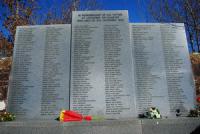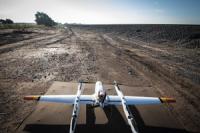-
Assessing the Danger of Drone Strike
The rapid rise in the number of drones worldwide has been accompanied by increasing reports of near misses with commercial aircraft. Bird-strike tests for aircraft are mandatory, but to date, however, there is no equivalent standard test procedure for collisions with drones.
-
-
Hezbollah operative collected sensitive information about Toronto Airport for potential future attack
An operative for the Iranian-backed terrorist organization Hezbollah collected “detailed information” about Toronto’s Pearson airport, according to a report released by Canada’s air safety agency on Tuesday. The Hezbollah operative also scouted New York’s JFK airport and U.S government facilities, as well as identifying Israelis in the United States who could be targeted by the Iranian-sponsored terrorist group.
-
-
Shoe scanner may improve airport security
The types of shoes you wear when flying matter. And not just shoe types. Size, material, soles and heels are also very important. Why? Shoes can become dangerous vehicles for terrorists’ plots. DHS wants to prevent future incidents, and this is why S&T is working on a millimeter wave technology for screening shoes as part of the larger Screening at Speed Program.
-
-
Hawk’s pursuit technique can help counter-drone defenses
Hawks steer their pursuit of evasive prey using a feedback system that differs fundamentally from the missile-like interception system of falcons.
-
-
Flying cars: automating the skies means playing with our lives

Recent research suggests that flying cars could eventually be a sustainable way to free up roads. The first models are set to hit our skies in 2019 as personal playthings, while industry sees them as taxis and commuter vehicles of the future. But as Harry Potter’s encounter with the Whomping Whillow reminds us, flying cars can be dangerous. Before futuristic visions of three-dimensional sprawling city traffic can approach reality, there are some serious safety issues that need addressing.
-
-
Flying colors: Assessing the role of flying cars in sustainable mobility

A new study of the environmental sustainability impacts of flying cars, formally known as electric vertical takeoff and landing aircraft, or VTOLs, finds that they wouldn’t be suitable for a short commute. However, VTOLs—which combine the convenience of vertical takeoff and landing like a helicopter with the efficient aerodynamic flight of an airplane—could play a niche role in sustainable mobility for longer trips.
-
-
Former East German agents questioned in Lockerbie bombing probe

Hundreds were killed when Pan Am Flight 103 exploded over the Scottish village of Lockerbie in December 1988. Libya later took responsibility and paid compensation to the victims’ families — and one of its secret agents spent eleven years in jail for the attack. Scottish and German investigators, acting on newly revealed information, are now looking onto the possibility that agents of STASI — East Germany’s secret police — were involved.
-
-
Securing drone traffic

In a couple of years, the number of drones in the U.S. national airspace is projected to grow to more than seven million. So many drones together in the air at once has the potential to create serious safety, efficiency and security issues if not regulated. The Unmanned Aircraft Systems Traffic Management (UTM) infrastructure will manage national airspace drone traffic in the future, and it is being rolled out in phases over time.
-
-
Increasing efficiency of air cargo screening

Air Cargo skids and pallets take up a large amount of space on every commercial passenger flight. Federal law requires this cargo be screened at the same level as checked baggage. Single and dual energy X-ray systems can be scaled up to screen air cargo skids, but they produce two-dimensional views of air cargo that are often difficult for screeners to interpret due to the complexity of the content’s image. Increases in computing power, algorithmic complexity, and machine learning capabilities offer opportunities to enhance current X-ray screening capabilities.
-
-
Drone jamming system to protect European airports, public spaces
Airports could be equipped with technology capable of detecting and bringing down drones that stray into their air space, according to Dan Hermansen, chief technology officer of Danish anti-drone firm MyDefence. The company has developed a drone alarm and protection system that is being installed at a number of prominent sites around Europe, including an airport. It has the potential to prevent the kind of costly disruption that hit London’s Gatwick and Heathrow airports recently.
-
-
Israeli Drone Dome helps Gatwick airport to avoid shutdown
Drone Dome, from Israeli defense company Rafael, pinpoints a suspicious drone and jams the radio frequencies used by its operator to control it, rendering the UAV unable to move. The British military had purchased the system a few months ago, and used it during the drone sightings at London’s Gatwick Airport.
-
-
Ways to stop a rogue drone
The mounting threat of drone users not following aviation regulation or committing crimes means police need effective ways to stop and capture rogue devices. One of the key challenges for any anti-drone counter-measure is that the typical small size of most drones makes them difficult to detect and target. One novel and widely reported idea being explored by the Dutch National Police is the training of bald eagles to down drones. A perfect solution has yet to be found, but interest and investment in drone countermeasures is increasing, giving authorities a growing number of options for tackling rogue drones.
-
-
More drone sightings at London's Gatwick airport
New drone sightings Friday caused more chaos for holiday travelers at London’s Gatwick Airport, which reopened in the morning after a 36-hour shutdown only to hastily suspend flights for more than an hour in the late afternoon on one of the busiest travel days of the year. The on-going chaos raised a host of questions for British officials, including how safe is it to fly with drones around and why can’t the country’s police, military and aviation experts catch those responsible since they have been investigating the drone invasions since Wednesday night.
-
-
Gatwick drone drama shows how even unarmed UAVs can cause economic chaos and risk to life
One of the amazing things about the recent drone incident at London Gatwick is that the appearance of two unmanned aerial vehicles flying into operational runway space prompted the closure of Britain’s second-busiest airport for more than a day. This is by no means the first incident of drones causing problems at airports, but the event at Gatwick is unusual in both the length of its duration and the presence and repeated use of multiple drones. The growing availability and affordability of consumer drones means that risks to airports, and other secure spaces will rise – and the counter-measures currently deployed against them leave room for improvement and need to be more widely adopted.
-
-
U.K.’s Gatwick Airport closed after drones fly over runways
Several sightings of unmanned aerial vehicles over the airport’s runway grounded and rerouted flights overnight. Gatwick is Britain’s second-busiest airport after Heathrow. The police said the drone flights were a “deliberate act to disrupt the airport,” but that there were “absolutely no indications to suggest this is terror-related.” In July 2018, the United Kingdom made it illegal to fly a drone within one kilometer (0.6 miles) of an airport, in an effort to tackle the issue.
-
- All
- Regional
- Water
- Biometrics
- Borders/Immig
- Business
- Cybersecurity
- Detection
- Disasters
- Government
- Infrastructure
- International
- Public health
- Public Safety
- Communication interoperabillity
- Emergency services
- Emergency medical services
- Fire
- First response
- IEDs
- Law Enforcement
- Law Enforcement Technology
- Military technology
- Nonlethal weapons
- Nuclear weapons
- Personal protection equipment
- Police
- Notification /alert systems
- Situational awareness
- Weapons systems
- Sci-Tech
- Sector Reports
- Surveillance
- Transportation
Advertising & Marketing: advertise@newswirepubs.com
Editorial: editor@newswirepubs.com
General: info@newswirepubs.com
2010-2011 © News Wire Publications, LLC News Wire Publications, LLC
220 Old Country Road | Suite 200 | Mineola | New York | 11501
Permissions and Policies
Editorial: editor@newswirepubs.com
General: info@newswirepubs.com
2010-2011 © News Wire Publications, LLC News Wire Publications, LLC
220 Old Country Road | Suite 200 | Mineola | New York | 11501
Permissions and Policies
